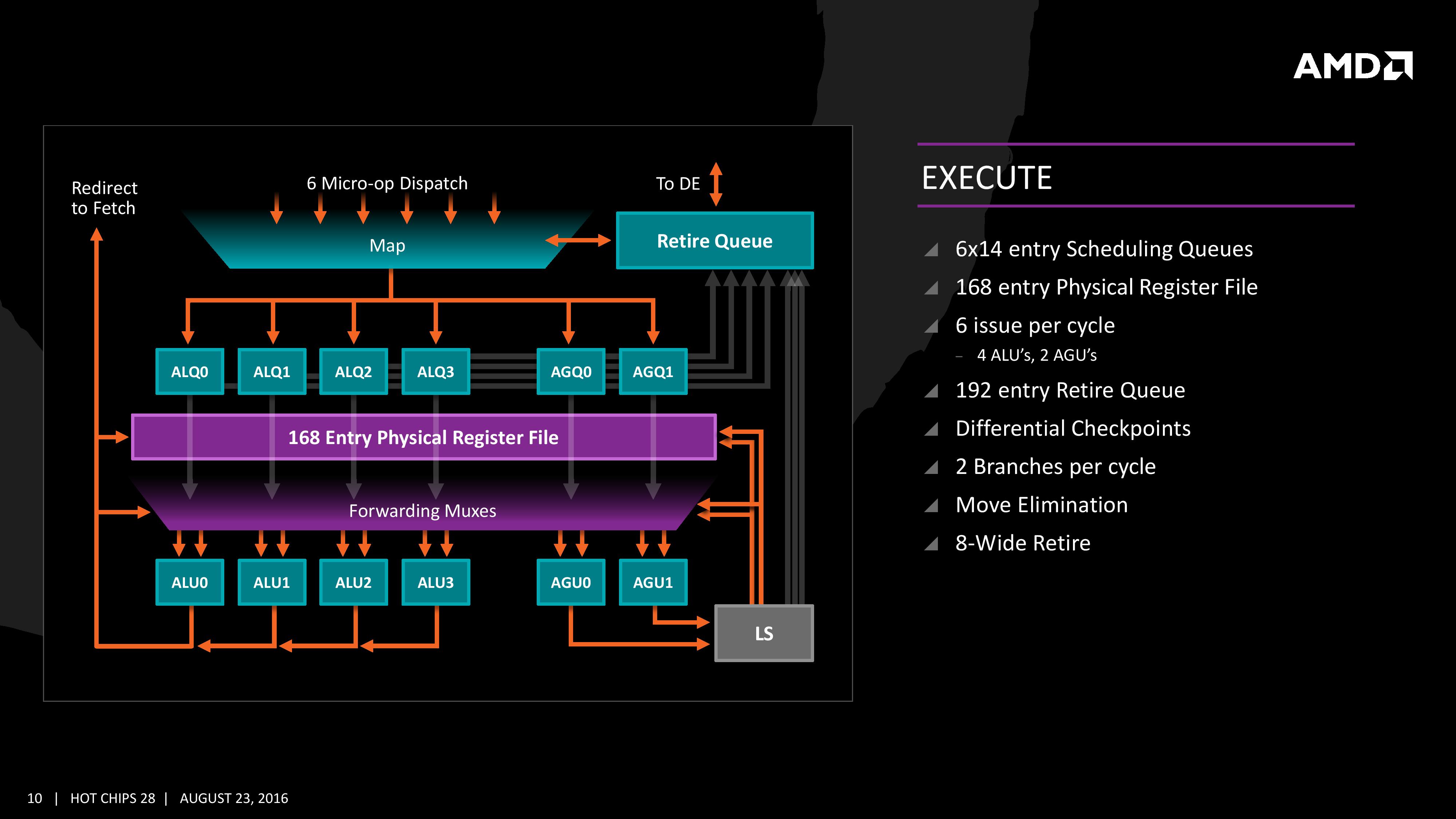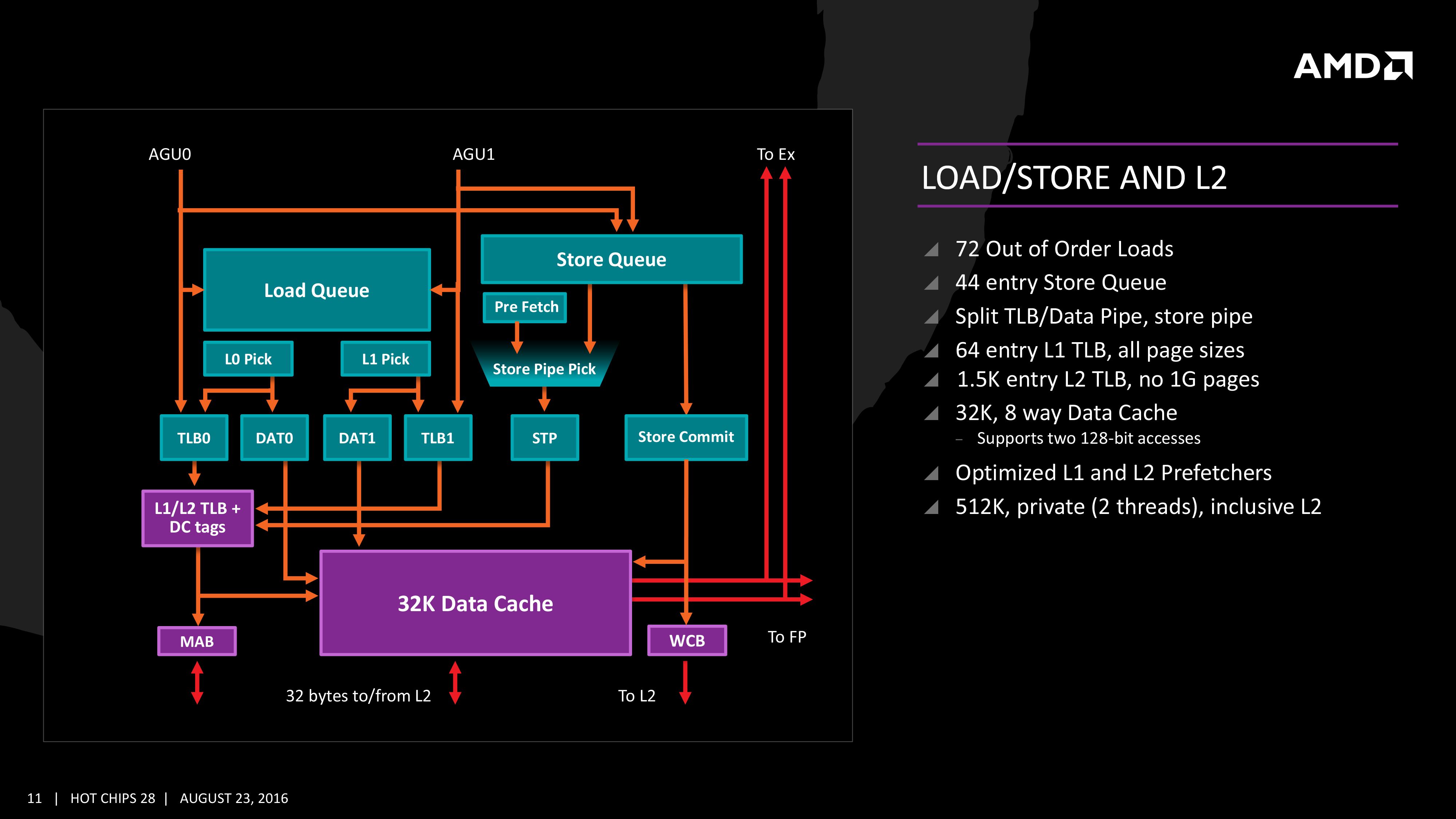The AMD Zen and Ryzen 7 Review: A Deep Dive on 1800X, 1700X and 1700
by Ian Cutress on March 2, 2017 9:00 AM ESTExecution, Load/Store, INT and FP Scheduling
The execution of micro-ops get filters into the Integer (INT) and Floating Point (FP) parts of the core, which each have different pipes and execution ports. First up is the Integer pipe which affords a 168-entry register file which forwards into four arithmetic logic units and two address generation units. This allows the core to schedule six micro-ops/cycle, and each execution port has its own 14-entry schedule queue.
The INT unit can work on two branches per cycle, but it should be noted that not all the ALUs are equal. Only two ALUs are capable of branches, one of the ALUs can perform IMUL operations (signed multiply), and only one can do CRC operations. There are other limitations as well, but broadly we are told that the ALUs are symmetric except for a few focused operations. Exactly what operations will be disclosed closer to the launch date.
The INT pipe will keep track of branching instructions with differential checkpoints, to cut down on storing redundant data between branches (saves queue entries and power), but can also perform Move Elimination. This is where a simple mov command between two registers occurs – instead of inflicting a high energy loop around the core to physically move the single instruction, the core adjusts the pointers to the registers instead and essentially applies a new mapping table, which is a lower power operation.
Both INT and FP units have direct access to the retire queue, which is 192-entry and can retire 8 instructions per cycle. In some previous x86 CPU designs, the retire unit was a limiting factor for extracting peak performance, and so having it retire quicker than dispatch should keep the queue relatively empty and not near the limit.
The Load/Store Units are accessible from both AGUs simultaneously, and will support 72 out-of-order loads. Overall, as mentioned before, the core can perform two 16B loads (2x128-bit) and one 16B store per cycle, with the latter relying on a 44-entry Store queue. The TLB buffer for the L2 cache for already decoded addresses is two level here, with the L1 TLB supporting 64-entry at all page sizes and the L2 TLB going for 1.5K-entry with no 1G pages. The TLB and data pipes are split in this design, which relies on tags to determine if the data is in the cache or to start the data prefetch earlier in the pipeline.
The data cache here also has direct access to the main L2 cache at 32 Bytes/cycle, with the 512 KB 8-way L2 cache being private to the core and inclusive. When data resides back in L1 it can be processed back to either the INT or the FP pipes as required.
Moving onto the floating point part of the core, and the first thing to notice is that there are two scheduling queues here. These are listed as ‘schedulable’ and ‘non-schedulable’ queues with lower power operation when certain micro-ops are in play, but also allows the backup queue to sort out parts of the dispatch in advance via the LDCVT. The register file is 160 entry, with direct FP to INT transfers as required, as well as supporting accelerated recovery on flushes (when data is written to a cache further back in the hierarchy to make room).
The FP Unit uses four pipes rather than three on Excavator, and we are told that the latency in Zen is reduced as well for operations (though more information on this will come at a later date). We have two MUL and two ADD in the FP unit, capable of joining to form two 128-bit FMACs, but not one 256-bit AVX. In order to do AVX, the unit will split the operations accordingly. On the counter side each core will have 2 AES units for cryptography as well as decode support for SSE, AVX1/2, SHA and legacy mmx/x87 compliant code.













574 Comments
View All Comments
Notmyusualid - Saturday, March 4, 2017 - link
Then why was the first 7700K at 199th place?The results dont' tie in with your retort.
Notmyusualid - Saturday, March 4, 2017 - link
And futhermore, 3dmark11 is a respected benchmark, that I and other PC games I know, use regularly.If you visit the 3DMark website, you will see LOADS of 3dmark11 results 'ticking in' on the global map.
And personally, every PC I've played with high 3dmark11 numbers has played games better than ones that have lower numbers, so you can't discount it. It works, whether you like it or not.
7700K, 199th place for 1080. Look it up. All above are X79, X99 type boards.
Aerodrifting - Sunday, March 5, 2017 - link
That just proved you really don't know anything about gaming, No point wasting my timNotmyusualid - Monday, March 6, 2017 - link
Then don't.Blissfull in ignorance..
Notmyusualid - Monday, March 6, 2017 - link
@ AerodriftingIn addition to MY comments on 3dMark11, try this from Guru3d, unless of course YOU always know better:
Quote:
3DMark 11 is the latest version of what is probably the most popular graphics card benchmark series. Designed to measure your PC's gaming performance, 3DMark 11 makes extensive use of all the new features in DirectX 11 including tessellation, compute shaders and multi-threading. Trusted by gamers worldwide to give accurate and unbiased results, 3DMark 11 is the best way to consistently and reliably test DirectX 11 under game-like loads. We test 3DMark 11 in performance mode which will give is a good indication of graphics card performance in the low, mid-range and high end graphics card segment.
And Link:
https://www.guru3d.com/articles_pages/geforce_gtx_...
And with that, I'm done here.
divertedpanda - Saturday, March 4, 2017 - link
"Everyone Know" ....... Except... Numbers don't lie.tmach - Thursday, March 2, 2017 - link
Yes and no. The $340 7700k beats the $1,000 6900k in gaming at stock speeds, too. That just goes to show that 8-cores still aren't for gaming, no matter how much some people (AMD included) want to make it a thing.GatesDA - Thursday, March 2, 2017 - link
They're not aimed at gamers; they're undercutting Intel's 6- and 8-core chips. Multithreading's the only reason to get a Ryzen 7, since the 6-core Ryzen 5 1600X will have the same clock speeds as the Ryzen 7 1800X for way less. Their unrevealed 4-core chips will probably be the gaming sweet spot.nader_21007 - Thursday, March 2, 2017 - link
well yeah you could stick more PCIe3 lanes and quad memory channels up your @$$.what use have these if the performance of your $1000 CPU is inferior to a $500 CPU? tell me.
prisonerX - Thursday, March 2, 2017 - link
Wow, gamers, that self-important 5% of the market. They'll never leave Intel anyway. When your customers are such rubes they'll pay top dollar for chips that contain 65% useless functionality, you can abuse them as much as you like. Gamers will still be buying 2% performance gains for generations to come.